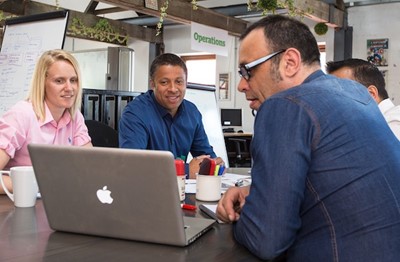
"I don’t stand up and speak. Most of my presentations are made sitting at a conference table."
It's likely we'll hear this from someone when we we take our on-site training to a company or organization.
In business settings, maybe you’re not standing on a stage—or even at the front of the room. Maybe your pitch is made across a desk or in a meeting around the conference table. In fact, maybe your presentation is more of a conversation, or at least structured to feel like one.
Good presentations from a seat at a table are not that different from those given on your feet. Here’s what we recommend:
1. Sit forward in your chair while presenting, with your feet planted on the floor.
"Anchors on the nightly news don’t slump in their chairs or cross a leg over, resting their ankle on their knee," says Buckley director Jenny Maxwell. "They sit up, ready to deliver and you should, too."
When speakers stand to present, Buckley coaches instruct them to space feet shoulder width apart for a firm foundation. When sitting, we find it helps to move forward in the chair and plant your feet solidly, so that you can control and energize your delivery.
 Sitting doesn't mean you take a holiday: Deliver to engage your audience, as you would for a standing presentation.
Sitting doesn't mean you take a holiday: Deliver to engage your audience, as you would for a standing presentation.
2. Use your upper body and gestures to support your message.
Just as you might in a standing presentation, you can also use body language and gestures to illustrate what you’re saying and show your passion for your message. Do you want us to weigh two options? You can show that with a gesture, perhaps both hands up to show two sides of a scale.
"Of course, gestures and body language at a conference table must be appropriate to the room, the message, and the audience," says Buckley faculty Katie Pope, our go-to coach when preparing for interviews. "Common sense says they probably shouldn’t be as large or dramatic as those you’d use for an audience of 500, for example."
3. Make eye contact with everyone around the table.
Good eye contact in a speech is individualized. You find someone in the room, make locking eye contact with them, then find another person in another part of the room and do the same. Your eye contact can work the same way around the conference table, showing everyone your desire to connect with them and get them involved in your message.
Again, you should be mindful of the situation, the audience, and your message. If, for example, you’re saying that a department has been underperforming for the last six months, you might not want to zero in on the colleague who heads that department—or his boss.
4. Have a plan, even when it’s a "conversation."
Some speakers use "I'll just speak from the heart" as a way to wiggle out of preparing their message. Likewise, presenters at the conference table may say "It's a conversation" to avoid having to prep.
A genuine conversation to discover client concerns, for example, is a worthy goal. But don’t go into that conversation unprepared. "Their time is valuable," says Buckley director Karen Kalutz, who regularly runs pitch workshops for sales teams. "They should understand why having a conversation with you has a benefit for them." To do that, she says you should have a plan for communicating that benefit early on and know the one main thing you want them to take away from your conversation.
 Make sure you convey the message and keep PowerPoint and other supporting material in that supporting role.
Make sure you convey the message and keep PowerPoint and other supporting material in that supporting role.
5. Don’t let PowerPoint slides do the talking for you.
"I can feel the smoke coming out of my ears when someone says, 'It’s on the slide. You can read it yourself,'" says Jenny. "It makes me angry because if that’s the case, why are we having a meeting? I can read at home in my sweatpants."
We often see presenters use a laptop or tablet to present to a few people. Some companies still use presentation books that they flip open and take people through.
No matter the medium, the speaker in this situation needs to provide the message. Refer to the visuals when the visuals make your message easier to understand. But for so many reasons—including the same ones that apply in stand up presentations—don’t think the PowerPoint is a stand in for you.
6. Manage your supporting handouts.
When you put information in people’s hands, they’ll look at it. Be sure they’re looking at in when you want them to see it—and not before.
We’ve written about how ESPN’s founder believes managing handouts helped him land funding to start the network.
Want to talk pricing? Don’t give them the numbers until you’re ready to talk about it. Want to keep their attention fixed on you? Don’t give them a summary of your presentation before you present it.
 Instead of giving handouts in advance, hold them until you're ready for everyone to read them.
Instead of giving handouts in advance, hold them until you're ready for everyone to read them.
When your seat is in the chair: Our bottom line
"You don’t have to stand up and deliver to be an effective presenter," Karen says, "but you do have to put in the same kind of work."
Well-planned and smartly-delivered, a seated presentation can be an effective, engaging, and more personalized way to encourage discussion, solve problems, and provide information your audience can use.
And one more thought: Just because you don't stand to deliver presentations right now in your career, doesn't mean you won't ever do it. Strong public speaking skills, in fact, can lead to new opportunities at work and help your reach personal goals, too.






